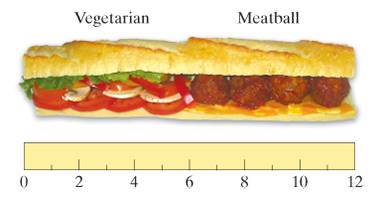
Concept explainers
Exercises 33 and 34 refer to the following situation: Jackie, Karla, and Lori are planning to divide the half vegetarian—half meatball foot-long sub sandwich shown in Fig. 3-22 among themselves using the lone- divider method. Jackie likes the meatball and vegetarian parts equally well; Karla is a strict vegetarian and does not eat meat at all; Lori likes the meatball part twice as much as the vegetarian part. (Assume that when the sandwich is cut, the cuts are always made perpendicular to the length of the sandwich. You can describe different shares of the sandwich using the ruler and interval notation—for example,

Figure 3-22
Suppose that Jackie is the divider.
a. Describe how Jackie should cut the sandwich into three shares. Label the three shares
b. Which of the three shares are fair shares to Karla?
c. Which of the three shares are fair shares to Lori?
d. Find three different fair divisions of the sandwich.
Want to see the full answer?
Check out a sample textbook solution
Chapter 3 Solutions
Excursions In Modern Mathematics, 9th Edition
- What do you guess are the standard deviations of the two distributions in the previous example problem?arrow_forward1 What is the area of triangle ABC? 12 60° 60° A D B A 6√√3 square units B 18√3 square units 36√3 square units D 72√3 square unitsarrow_forwardEach answer must be justified and all your work should appear. You will be marked on the quality of your explanations. You can discuss the problems with classmates, but you should write your solutions sepa- rately (meaning that you cannot copy the same solution from a joint blackboard, for exam- ple). Your work should be submitted on Moodle, before February 7 at 5 pm. 1. True or false: (a) if E is a subspace of V, then dim(E) + dim(E) = dim(V) (b) Let {i, n} be a basis of the vector space V, where v₁,..., Un are all eigen- vectors for both the matrix A and the matrix B. Then, any eigenvector of A is an eigenvector of B. Justify. 2. Apply Gram-Schmidt orthogonalization to the system of vectors {(1,2,-2), (1, −1, 4), (2, 1, 1)}. 3. Suppose P is the orthogonal projection onto a subspace E, and Q is the orthogonal projection onto the orthogonal complement E. (a) The combinations of projections P+Q and PQ correspond to well-known oper- ators. What are they? Justify your answer. (b) Show…arrow_forward
- pleasd dont use chat gptarrow_forward1. True or false: (a) if E is a subspace of V, then dim(E) + dim(E+) = dim(V) (b) Let {i, n} be a basis of the vector space V, where vi,..., are all eigen- vectors for both the matrix A and the matrix B. Then, any eigenvector of A is an eigenvector of B. Justify. 2. Apply Gram-Schmidt orthogonalization to the system of vectors {(1, 2, -2), (1, −1, 4), (2, 1, 1)}. 3. Suppose P is the orthogonal projection onto a subspace E, and Q is the orthogonal projection onto the orthogonal complement E. (a) The combinations of projections P+Q and PQ correspond to well-known oper- ators. What are they? Justify your answer. (b) Show that P - Q is its own inverse. 4. Show that the Frobenius product on n x n-matrices, (A, B) = = Tr(B*A), is an inner product, where B* denotes the Hermitian adjoint of B. 5. Show that if A and B are two n x n-matrices for which {1,..., n} is a basis of eigen- vectors (for both A and B), then AB = BA. Remark: It is also true that if AB = BA, then there exists a common…arrow_forwardQuestion 1. Let f: XY and g: Y Z be two functions. Prove that (1) if go f is injective, then f is injective; (2) if go f is surjective, then g is surjective. Question 2. Prove or disprove: (1) The set X = {k € Z} is countable. (2) The set X = {k EZ,nЄN} is countable. (3) The set X = R\Q = {x ER2 countable. Q} (the set of all irrational numbers) is (4) The set X = {p.√2pQ} is countable. (5) The interval X = [0,1] is countable. Question 3. Let X = {f|f: N→ N}, the set of all functions from N to N. Prove that X is uncountable. Extra practice (not to be submitted). Question. Prove the following by induction. (1) For any nЄN, 1+3+5++2n-1 n². (2) For any nЄ N, 1+2+3++ n = n(n+1). Question. Write explicitly a function f: Nx N N which is bijective.arrow_forward
- 3. Suppose P is the orthogonal projection onto a subspace E, and Q is the orthogonal projection onto the orthogonal complement E. (a) The combinations of projections P+Q and PQ correspond to well-known oper- ators. What are they? Justify your answer. (b) Show that P - Q is its own inverse.arrow_forwardAre natural logarithms used in real life ? How ? Can u give me two or three ways we can use them. Thanksarrow_forwardBy using the numbers -5;-3,-0,1;6 and 8 once, find 30arrow_forward
- Show that the Laplace equation in Cartesian coordinates: J²u J²u + = 0 მx2 Jy2 can be reduced to the following form in cylindrical polar coordinates: 湯( ди 1 8²u + Or 7,2 მ)2 = 0.arrow_forwardDraw the following graph on the interval πT 5π < x < x≤ 2 2 y = 2 cos(3(x-77)) +3 6+ 5 4- 3 2 1 /2 -π/3 -π/6 Clear All Draw: /6 π/3 π/2 2/3 5/6 x 7/6 4/3 3/2 5/311/6 2 13/67/3 5 Question Help: Video Submit Question Jump to Answerarrow_forwardDetermine the moment about the origin O of the force F4i-3j+5k that acts at a Point A. Assume that the position vector of A is (a) r =2i+3j-4k, (b) r=-8i+6j-10k, (c) r=8i-6j+5karrow_forward
 Linear Algebra: A Modern IntroductionAlgebraISBN:9781285463247Author:David PoolePublisher:Cengage Learning
Linear Algebra: A Modern IntroductionAlgebraISBN:9781285463247Author:David PoolePublisher:Cengage Learning
